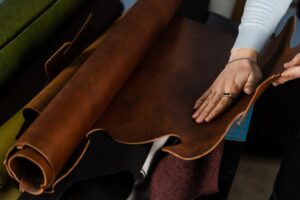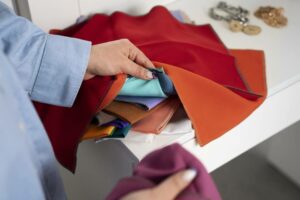As time progresses, the field of upholstery in interior design has undergone remarkable advancements.
Innovations and enhancements of traditional concepts have empowered the industry to craft increasingly intricate and appealing designs, meeting clients’ needs more effectively than ever before.
This article delves into the diverse range of upholstery fabrics and their influence on room aesthetics. We will also offer guidance on how to select the perfect fabric to complement your design.
The Timeless Role of Upholstery in Interior Design

In interior design, the choice of upholstery fabric plays a pivotal role, both aesthetically and functionally.
From setting the mood to defining the character of a room, upholstery can truly make or break the ambience.
It is the silent yet eloquent influencer that determines the look, mood, and feel of a space, creating an atmosphere that aligns with your design intentions.
Popular Upholstery Fabric Choices & Their Impacts in Interior Design

1. Silk: The Epitome of Luxury
Silk is the embodiment of luxury and elegance and is often reserved for formal living rooms and adult-only spaces.
Its delicate texture and sheen elevate any room into a luxurious sanctuary.
2. Rayon: Modern Favourite for Durability and Flow
Similarly, rayon offers a luxurious feel like silk but is far more affordable and durable, making it a favourite for everyday living spaces.
Its ability to mimic the drape and feel of natural fibres while offering resilience is a big plus.
3. Leather: A Blend of Sophistication and Academia
Alternatively, leather brings a sophisticated and classic aura to a room. It’s a common choice for dens, home offices, and academic settings, offering both durability and timeless beauty.
4. Cotton: Natural, Versatile, and Comfortable
Cotton is both comfortable and versatile, aligning well with a variety of design themes. From country to modern chic, it provides a natural touch that complements any space.
5. Polyester Blends: Practicality Meets Style
For spaces that need to withstand the chaos of children or outdoor elements, polyester blends offer both resilience and stain resistance without compromising on aesthetic appeal.
6. Velvet: For Opulent Sophistication
Velvet is the fabric of choice when sophistication is the desired end goal.
Ideal for grand settings like formal living rooms or master suites, velvet offers a lush feel and look that is hard to match.
7. Microfibre: Budget-Friendly Luxe
However, if you love the look and feel of velvet but need something more affordable and easier to maintain, microfibre is an excellent choice.
Its plush texture brings comfort, while its durability ensures longevity.
Read more: Pocket Spring Sofa: Your Complete Guide to Sofa Springs
Expert Tips for Choosing the Perfect Upholstery in Interior Design

1. Prioritise Durability for Longevity
Firstly, upholstery is an investment, so durability should be a top priority. A longer-lasting fabric means less frequent replacements, contributing to a sustainable and lasting design.
2. Master the Art of Complement and Contrast
Next, when choosing upholstery in interior design, consider how it will blend with other elements in the room.
Look for the right balance between complementing and contrasting colours and textures to elevate the overall design.
3. Ensure Colour Quality for Vibrancy
You should also opt for fabrics that can withstand environmental factors like sunlight and moisture to maintain their colour vibrancy over time.
4. Keep Long-Term Vision in Mind
Moreover, investing in high-quality upholstery ensures that your furniture and overall room aesthetic stand the test of time. A well-thought-out choice can last for years if not decades.
5. Functionality is Key
Your upholstery choice should also align with the function of the room and the furniture piece. For example, easy-to-clean fabrics are ideal for a child’s room or outdoor furniture.
6. Embrace the Art of Layering
Layering different types of fabric can add depth to a room, making it feel more dynamic and visually interesting. It also acts as a layer of protection for your furniture.
7. Respect the Integrity of the Furniture Piece
Likewise, the upholstery should enhance the furniture piece, not overpower it. Choose fabrics that contribute to the furniture’s character and purpose.
8. Customisation Solutions for Your Clients
If you’re a furniture manufacturer or interior design firm, offering custom upholstery options can set you apart from competitors.
Partnering with a specialised fabric supplier can provide you with the quality and variety needed to meet requirements, allowing you to offer a tailored experience.
9. Always Sample Before Finalising
It is also worth noting that fabrics can look dramatically different under different lighting.
Always take samples to see how they will fit and elevate the overall furniture design that you have in mind.
10. Consider Repurposing Fabrics
Lastly, recycling old upholstery fabrics for different applications or furniture pieces is both eco-friendly and cost-effective. It’s a creative way to give old fabrics new life.
Read More: Fabric for Sofa: Ultimate Guide to Selecting the Best Material
Find Your Ideal Upholstery Fabric Today!
In conclusion, upholstery fabrics hold weight in interior design. The furniture industry will always create innovations to better fit the design trends among consumers.
As a leading upholstery fabric supplier in Malaysia, Kintex offers a wide variety of choices that cater to every style and need.
Explore our extensive upholstery fabric collection today and transform your consumers’ living spaces into something truly spectacular.







